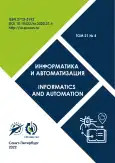Volume 21, Nº 4 (2022)
Artificial intelligence, knowledge and data engineering
Randomized Machine Learning and Forecasting of Nonlinear Dynamic Models Applied to SIR Epidemiological Model
Resumo
 659-677
659-677


Analytical Review of Methods for Solving Data Scarcity Issues Regarding Elaboration of Automatic Speech Recognition Systems for Low-Resource Languages
Resumo
 678-709
678-709


Apple Leaf Disease Classification Using Image Dataset: a Multilayer Convolutional Neural Network Approach
Resumo
Agriculture is one of the prime sources of economic growth in Russia; the global apple production in 2019 was 87 million tons. Apple leaf diseases are the main reason for annual decreases in apple production, which creates huge economic losses. Automated methods for detecting apple leaf diseases are beneficial in reducing the laborious work of monitoring apple gardens and early detection of disease symptoms. This article proposes a multilayer convolutional neural network (MCNN), which is able to classify apple leaves into one of the following categories: apple scab, black rot, and apple cedar rust diseases using a newly created dataset. In this method, we used affine transformation and perspective transformation techniques to increase the size of the dataset. After that, OpenCV crop and histogram equalization method-based preprocessing operations were used to improve the proposed image dataset. The experimental results show that the system achieves 98.40% training accuracy and 98.47% validation accuracy on the proposed image dataset with a smaller number of training parameters. The results envisage a higher classification accuracy of the proposed MCNN model when compared with the other well-known state-of-the-art approaches. This proposed model can be used to detect and classify other types of apple diseases from different image datasets.
 710-728
710-728


Robotics, automation and control systems
Analytical Review of Approaches to the Distribution of Tasks for Mobile Robot teams Based on Soft Computing Technologies
Resumo
 729-757
729-757


Improving the Accuracy of IP Geolocation Based on Public IP Geoservices Data
Resumo
 758-785
758-785


Method for Determining the Functional Dependences of Working Outputs of Logic Combination Schemes for Development Unidirectional Errors
Resumo
 786-811
786-811


Method of Structural-Parametric Synthesis of Configuration Multi-Mode Object
Resumo
 812-845
812-845











